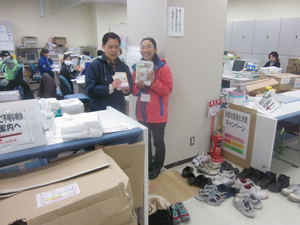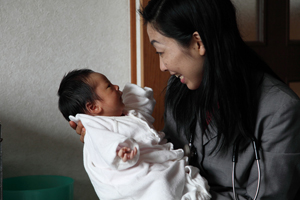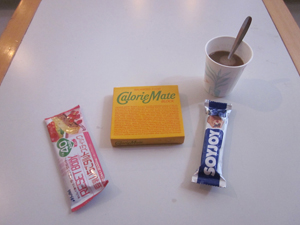1. The utmost care and measures to be taken for mothers-to-be
When a disaster, conflict, or civil war occurs, the media often broadcasts the plight of the elderly and children. Because the disaster area this time is an aging society, the news has tended to focus on chronic diseases of the elderly (e.g. high blood pressure, diabetes, longstanding heart disease) and malnutrition.
In times like this, what I always think about is whether the care for expectant or postpartum mothers is not being overlooked. Young mothers seem to be happy and healthy just because they are young or they are with their babies. However, the mental and physical strain required to keep herself and the baby in good condition as well as to endure the rapid development of the baby is enormous. Moreover, they also require greater food intake; pregnant women need much more mental energy than when they are not pregnant, because they are working hard to stay in good physical and psychological condition and the least little thing can tire them.
When last time I participated in support activities in the disaster area three weeks ago, I met many pregnant women who think that they should not be prioritized over the elderly and who care about others. However, it is the expectant and postpartum mothers who need the time to breastfeed their baby safely in a quiet place and rest. Everyone in the disaster area has a hard time. However, due to the maternal instinct to protect their babies, mothers become very nervous about the temperature, noise, brightness, and other people. Babies have their own unique lifestyle cycles. Mothers cannot eat and sleep according to their baby's lifestyle. They become stressed by the cumulative inconvenience that results from living together with other people.
In 1995, more than 40 NGOs including the United Nations, universities, and international organizations got together and formed a group called the Inter-agency Working Group (IAWG) to present problems. Based on the common experience of disaster that had occurred in each country, they advocated a policy of reproductive health for displaced people in the disaster area to emphasize the family and raising children, and stated that the primary cause of death among women was related to reproductive health issues (including childbirth, sex crime, sexually transmitted disease such as HIV). Even without conducting a survey, these problems are known to exist in disaster-stricken areas. The Minimum Initial Service Package (MISP)*1 provides guidelines for support activities with immediate intervention to prevent the death of expectant and postpartum mothers and newborn babies in the disaster.
The Guidelines are also presented in the "Sphere Humanitarian Charter and Minimum Standards in Disaster Response (so-called: Sphere Handbook)*2", which is also known as the standard for support measures in a disaster area. The Guidelines are well-known among the specialists doing fieldwork on issues of developing countries and refugees in a disaster. The "Sphere" consists of the humanitarian support organizations, the Red Cross, and NGOs. They work together to share knowledge and experience both successful and unsuccessful. I felt such an attitude was helpful for the support activities in the disaster area this time.

Delivering the aid supplies to the administrators in the disaster area
2. Care for children
I am a mother and an OB/GYN doctor. Therefore, I strongly feel that the special care for children is needed. Children instinctively want to enjoy, laugh at, and play with everything. When being with children, I am always surprised that children talk a lot, laugh a lot, and have a talent for turning everything into something interesting to play with. I have seen at many hospitals that the children lose their smile if they become sick or experience trauma. Being different from adults who often keep their feelings inside, when children do not smile, it means they are going through a lot of stress. Children cannot express their feelings verbally, and they show their feelings only to adults whom they can trust. In the disaster area and evacuation centers, it is difficult to consider playing and learning opportunity for children. However, play, desire for learning, and interest are fundamental and spiritual nourishment for children. Children are comforted, by talking and laughing with peers, which is a different way from that of adults. The dispatched doctors learned about mental care for children during the PCAT (Please refer to the "Report from the Disaster Area Part 2") orientation to deepen their understanding. Such preparatory learning was very helpful, but we should not take only a professional stance to "mental care." It is also important to simply say "hi" to children when seeing them; to be interested in them; tell a joke; ask what happened on that day or what they like to play; and just speak to them about anything. Children want us to be interested in them, to get involved with them and praise them.
I spoke to families I did not know, praised their children by saying "Oh, cute!" or "Good job!" and asked them "What kind of animals (subjects, food, ride, play) do you like?" I tried to talk about usual things with them naturally in the disaster area. At that time, I was very impressed that the children in the disaster area still had their childlikeness. They were shy at first, but gradually showed me their favorite playthings or pastimes, such as folding paper, string figures, and playing ball.

Treating a newborn infant
3. Nutritional support for pregnant women in the disaster area
The following is nutritional advice for expectant and postpartum mothers and mothers with infants, taken from the material published by the National Institute of Health and Nutrition titled: "3. Leaflet for babies, pregnant women, and nursing mothers."
(1) Do not try too hard!
Consult medical staff anytime when experiencing trouble.
Sometimes, you cannot control many things including continuation of breast-feeding, disinfecting of dishes and milk bottles, and maintaining a nutritional balance for your baby and yourself. Speak up if you have any problems and considerations. You will feel better and will be able to organize your thoughts by just talking about your concerns to someone else. Weighing all the advantages and disadvantages of nutritional benefits, urgency, and necessity, at the same time people around nervous pregnant women should try to comfort them by letting them know that "It is OK to just do your best in the given situation." or "It is OK, because we do not have any other choice under the circumstances."
(2) Drink water whenever you can
People try not to drink water because sufficient water cannot be provided, they do not want to go to the bathroom often, or they want to save it instead. However, it is important to make an effort to drink water frequently because it is necessary to drink more water than usual at this time.
(3) Eat whenever you can
Sometimes the number and size of meals are restricted, or you feel little appetite. However, eat whatever you can get whenever you can.
(4) How to replenish lost vitamins
Choose rice balls rather than bread, especially rice balls that contain as much vegetables as possible. Taking fruit juice, nutrition-fortified food products, energy drink, and jelly drink will help provide vitamins to your body.

Breakfast for the volunteers
(5) Do not stick to the conventions of baby food
Babies can be fed slightly miso-flavored rice porridge or well-boiled mashed vegetables. Some mothers are nervous about feeding their babies with milk and eggs because they can be allergy-provoking. However, babies are stronger than we think. Feed them with whatever you can get under the given situation.
As an OB/GYN doctor, my goal was "good delivery." However, I went through a hard time after having my first baby and learned that childbirth was a start, not a goal. I would like people to pay more attention to and take better care of mothers after they have a child. I want to decrease the number of mothers who are suffering from child-rearing anxiety. I want to comfort mothers who feel "a sense of desolation" even knowing childrearing is important work. I care about mothers who put off their self-care. Mothers' happiness is the core ? it will help prevent child abuse and foster cheerful and loving children.
The original report was posted on the CRN Japanese site in April 2011.
*1 The Minimum Initial Service Package (MISP) is available in multiple languages and can be downloaded here.
*2 The "Sphere Handbook" is available in multiple languages and can be downloaded here.














